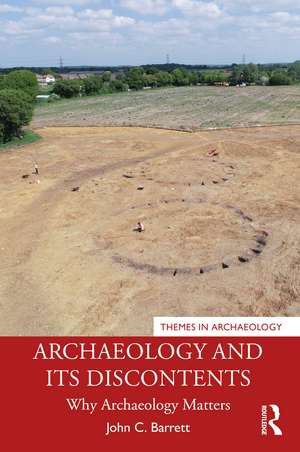Archaeology and its Discontents: Why Archaeology Matters: Themes in Archaeology Series
Autor John C. Barretten Limba Engleză Paperback – 31 mar 2021
Surveying the themes of twentieth-century archaeological theory, Barrett looks at their successes, limitations, and failures. Seeing more failures and limitations than successes, he argues that archaeology has over-focused on explaining the human construction of material variability and should instead be more concerned with understanding how human diversity has been constructed. Archaeology matters, he argues, precisely because of the insights it can offer into the development of human diversity. The analysis and argument are illustrated throughout by reference to the development of the European Neolithic.
Arguing both for new approaches and for the importance of archaeology as a discipline, Archaeology and its Discontents is for archaeologists at all levels, from student to professor and trainee to experienced practitioner.
| Toate formatele și edițiile | Preț | Express |
|---|---|---|
| Paperback (1) | 298.94 lei 3-5 săpt. | +32.17 lei 6-10 zile |
| Taylor & Francis – 31 mar 2021 | 298.94 lei 3-5 săpt. | +32.17 lei 6-10 zile |
| Hardback (1) | 764.87 lei 6-8 săpt. | |
| Taylor & Francis – 31 mar 2021 | 764.87 lei 6-8 săpt. |
Din seria Themes in Archaeology Series
-
 Preț: 344.12 lei
Preț: 344.12 lei -
 Preț: 286.14 lei
Preț: 286.14 lei - 16%
 Preț: 249.06 lei
Preț: 249.06 lei -
 Preț: 286.55 lei
Preț: 286.55 lei -
 Preț: 359.68 lei
Preț: 359.68 lei -
 Preț: 347.46 lei
Preț: 347.46 lei
Preț: 298.94 lei
Nou
Puncte Express: 448
Preț estimativ în valută:
57.23€ • 58.86$ • 47.48£
57.23€ • 58.86$ • 47.48£
Carte disponibilă
Livrare economică 29 ianuarie-12 februarie
Livrare express 14-18 ianuarie pentru 42.16 lei
Preluare comenzi: 021 569.72.76
Specificații
ISBN-13: 9780367556457
ISBN-10: 0367556456
Pagini: 180
Ilustrații: 6 Line drawings, black and white; 6 Illustrations, black and white
Dimensiuni: 156 x 234 x 10 mm
Greutate: 0.7 kg
Ediția:1
Editura: Taylor & Francis
Colecția Routledge
Seria Themes in Archaeology Series
Locul publicării:Oxford, United Kingdom
ISBN-10: 0367556456
Pagini: 180
Ilustrații: 6 Line drawings, black and white; 6 Illustrations, black and white
Dimensiuni: 156 x 234 x 10 mm
Greutate: 0.7 kg
Ediția:1
Editura: Taylor & Francis
Colecția Routledge
Seria Themes in Archaeology Series
Locul publicării:Oxford, United Kingdom
Cuprins
Introduction 1. Explanation and understanding 2. The archaeological record 3. Systems and the dynamics of historical change: The New Archaeology 4. A Social Archaeology 5. From functionalism to a symbolic and structural archaeology 6. The evolution of ecosystems 7. The making of populations 8. The cultures of life Epilogue
Notă biografică
John C. Barrett is Emeritus Professor of Archaeology at the University of Sheffield, having previously taught at the Universities of Leeds and Glasgow. He is the author of Fragments from Antiquity (1994) and co-author, with Michael Boyd, of From Stonehenge to Mycenae (2019). His research has focused upon British and European prehistory and archaeological theory.
Recenzii
"Archaeology and Its Discontents is a challenging, and immensely stimulating read." - Mike Pitts, British Archaeology
"Archaeology and Its Discontents is a book I cannot praise enough; it should be required reading for all archaeologist, and not just those interested in prehistory." - Stratos Nanoglou, American Journal of Archaeology
"Archaeology and Its Discontents is a valuable contribution to debating the histories of archaeological philosophies and for understanding the field’s relevance to ecological humanities." - Stephanie Koerner, Antiquity
"Archaeology and Its Discontents is a book I cannot praise enough; it should be required reading for all archaeologist, and not just those interested in prehistory." - Stratos Nanoglou, American Journal of Archaeology
"Archaeology and Its Discontents is a valuable contribution to debating the histories of archaeological philosophies and for understanding the field’s relevance to ecological humanities." - Stephanie Koerner, Antiquity
Descriere
Critically examines the state of archaeology today and its development throughout the twentieth century. It makes a powerful case that understanding how humans have created themselves should be the main purpose of archaeology, and that archaeology matters precisely because of the insights it can offer in this area.
